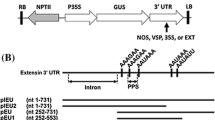Abstract
A chimeric gene encoding a ribozyme under the control of the cauliflower mosaic virus (CaMV) 35S promoter was introduced into transgenic tobacco plants. In vivo activity of this ribozyme, which was designed to cleave npt mRNA, was previously demonstrated by transient expression assays in plant protoplasts. The ribozyme gene was transferred into transgenic tobacco plants expressing an rbcS-npt chimeric gene as an indicator. Five double transformants out of sixteen exhibited a reduction in the amount of active NPT enzyme. To measure the amount of ribozyme produced, in the absence of its target, the ribozyme and target genes were separated by genetic segregation. The steady-state concentrations of ribozyme and target RNA were shown to be similar in the resulting single transformants. Direct evidence for a correlation between reduced npt gene expression and ribozyme expression was provided by crossing a plant containing only the ribozyme gene with a transgenic plant expressing the npt gene under control of the 35S promoter, i.e. the same promoter used to direct ribozyme expression. The expression of npt was reduced in all progeny containing both transgenes. Both steady-state levels of npt mRNA and amounts of active NPT enzyme are decreased. In addition, our data indicate that, at least in stable transformants, a large excess of ribozyme over target is not a prerequisite for achieving a significant reduction in target gene expression.
Similar content being viewed by others
References
Cameron F, Jennings P (1989) Specific gene suppression by engineered ribozymes in monkey cells. Proc Natl Acad Sci USA 86:9139–9143
Capecchi MR (1989) Altering the genome by homologous recombination. Science 244:1283–1292
Cotten M, Birnstiel ML (1989) Ribozyme mediated destruction of RNA in vivo. EMBO J 8:3861–3866
Ecker JR, Davies RW (1986) Inhibition of gene expression in plant cells by expression of antisense DNA. Proc Natl Acad Sci USA 83:5372–5376
Forster AC, Symons RH (1987) Self-cleavage of plus and minus RNAs of a virusoid and a structural model for the active sites. Cell 49:211–220
Fritz CC, Herget T, Wolter FP, Schell J, Schreier PH (1991) Reduced steady-state levels of rbcS mRNA in plants kept in the dark are due to differential degradation. Proc Natl Acad Sci USA 88.4458–4462
Fritz CC, Wolter FP, Schenkemeyer V, Herget T, Schreier PH (1993) The gene family of ribulose -(1,5)-bisphosphate carboxylase/oxygenase small subunit from potato. Gene 137:271–274
Hamilton AJ, Lycett GW, Grierson D (1990) Antisense gene that inhibits synthesis of the hormone ethylene in transgenic plants. Nature 346:284–287
Haseloff J, Gerlach W (1988) Simple RNA enzymes with new and highly specific endoribonuclease activities. Nature 334:585–591
Herminghaus S, Schreier PH, McCarthy JEG, Landsmann J, Bottermann J, Berlin J (1991) Expression of a bacterial lysine decarboxylase gene and transport of the protein into chloroplasts of transgenic tobacco. Plant Mol Biol 17:475–486
Koncz C, Schell J (1986) The promoter of the TL-DNA gene 5 controls the tissue-specific expression of chimaeric genes carried by a novel type of Agrobacterium binary vector. Mol Gen Genet 204:383–396
van der Krol AR, Lenting PE, Veenstra J, van der Meer IM, Gerats AGM, Mol JNM, Stuitje AR (1988) An antisense chalcone synthase gene in transgenic plants inhibits flower pigmentation. Nature 333:866–869
L'Hullier PJ, Davies SR, Bellamy RA (1992) Cytoplasmic delivery of ribozymes leads to efficient reduction in α-lactalbumin mRNA levels in C1271 mouse cells. EMBO J 11:4411–4418
Paszkowski J, Baur M, Bogucki A, Potrykus I (1988) Gene targeting in plants. EMBO J 7:4021–4026
Reiss B, Sprengel R, Will H, Schaller H (1984) A new sensitive method for qualitative and quantitative assay of neomycin phosphotransferase in crude cell extracts. Gene 30:211–218
Rodermel SR, Abbott MS, Bogorad L (1988) Nuclear-organelle relationships: nuclear antisense gene inhibits ribulose bisphosphate carboxylase enzyme levels in chloroplasts of transformed tobacco plants. Cell 55:673–681
Saxena SK, Ackerman EJ (1990) Ribozymes correctly cleave a model substrate and endogenous RNA in vivo. J Biol Chem 265:17106–17109
Schreier PH, Seftor EA, Schell J, Bohnert HJ (1985) The use of nuclear encoded sequences to direct the light-regulated synthesis and transport of a foreign protein into plant chloroplasts. EMBO J 4:25–32
Smith CJS, Watson CF, Ray J, Bird CR, Morris PC, Schuch W, Grierson D (1988) Antisense RNA inhibition of polygalacturonase gene expression in transgenic tomatoes. Nature 334:724–726
Steinecke P, Herget T, Schreier PH (1992) Expression of a chimeric ribozyme gene results in endonucleolytic cleavage of target mRNA and a concomitant reduction of gene expression in vivo. EMBO J 11:1525–1530
Tsuchihashi Z, Khosla M, Herschlag D (1993) Protein enhancement of hammerhead ribozyme catalysis. Science 262:99–102
Uhlenbeck OC (1987) A small catalytic oligoribonucleotide. Nature 328:596–600
Wing D, Koncz C, Schell J (1989) Conserved function in Nicotiana tabacum of a single Drosophila hsp70 promoter heat shock element when fused to a minimal T-DNA promoter. Mol Gen Genet 219:9–16
Zhao JJ, Pick L (1993) Generating loss-of-function phenotypes of the fushi tarazu gene with a targeted ribozyme in Drosophila. Nature 365:448–451
Author information
Authors and Affiliations
Additional information
Communicated by R. Hagemann
Rights and permissions
About this article
Cite this article
Wegener, D., Steinecke, P., Herget, T. et al. Expression of a reporter gene is reduced by a ribozyme in transgenic plants. Molec. Gen. Genet. 245, 465–470 (1994). https://doi.org/10.1007/BF00302259
Received:
Accepted:
Issue Date:
DOI: https://doi.org/10.1007/BF00302259




